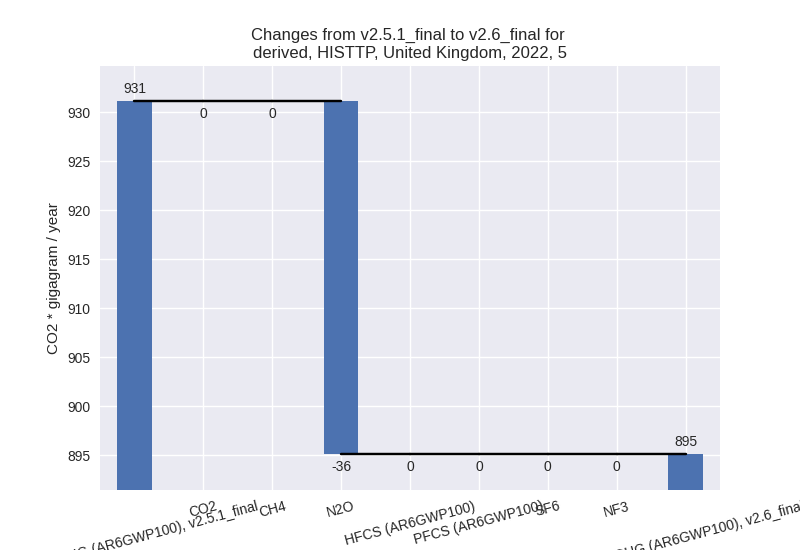Changes in PRIMAP-hist v2.6_final compared to v2.5.1_final for United Kingdom
2024-09-24
Johannes Gütschow
Change analysis for United Kingdom for PRIMAP-hist v2.6_final compared to v2.5.1_final
Overview over emissions by sector and gas
The following figures show the aggregate national total emissions excluding LULUCF AR6GWP100 for the country reported priority scenario. The dotted linesshow the v2.5.1_final data.
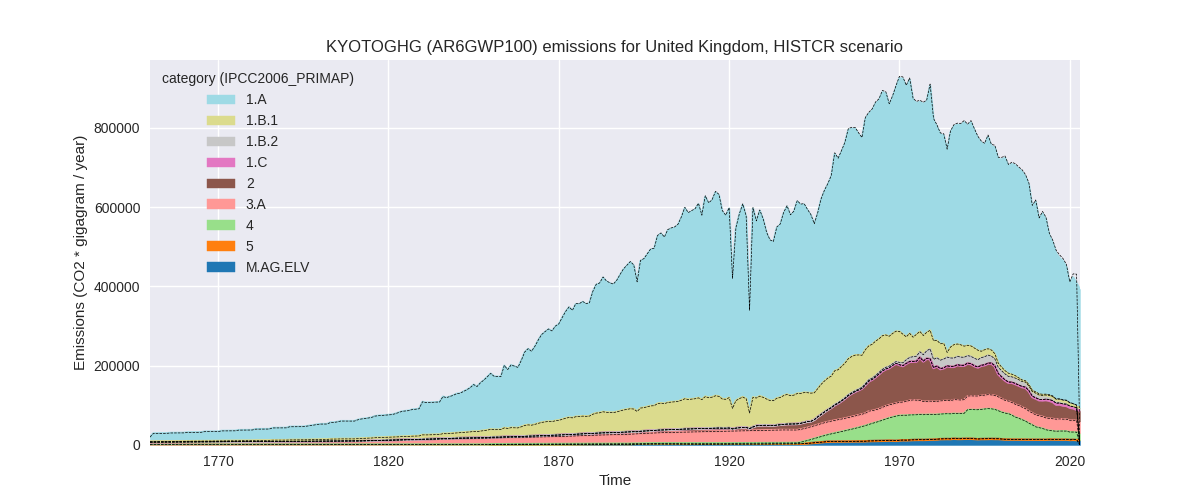

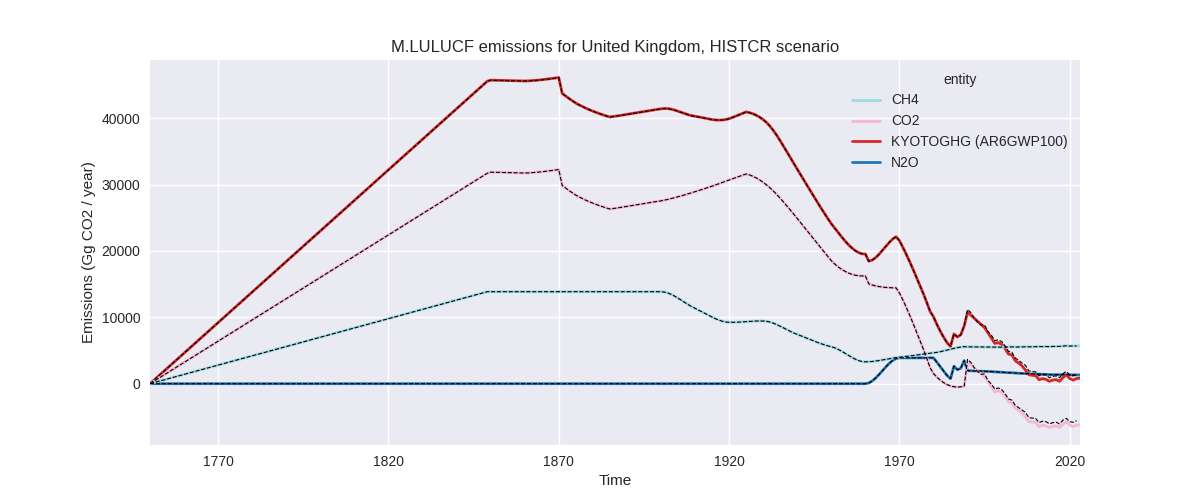
The following figures show the aggregate national total emissions excluding LULUCF AR6GWP100 for the third party priority scenario. The dotted linesshow the v2.5.1_final data.
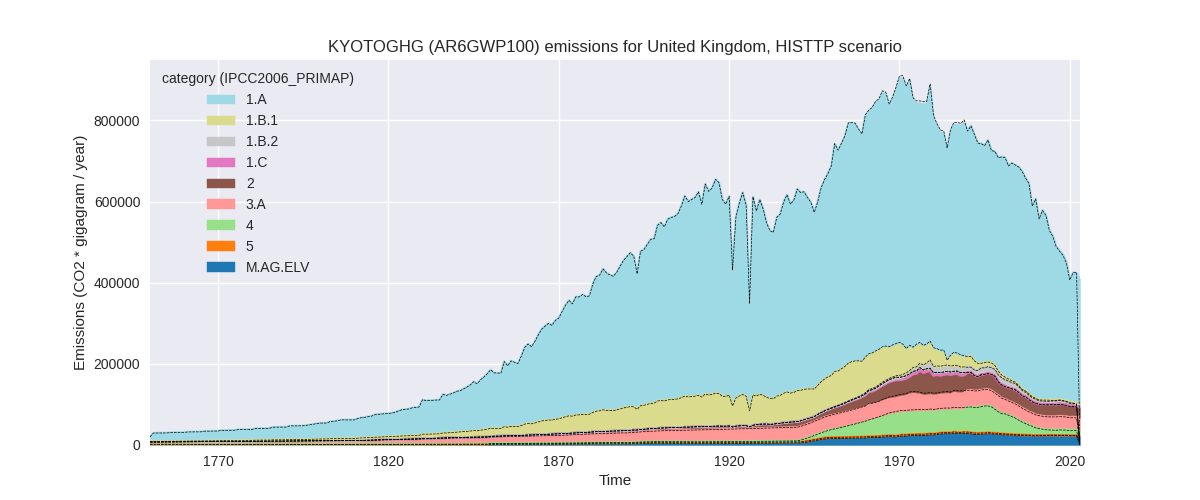
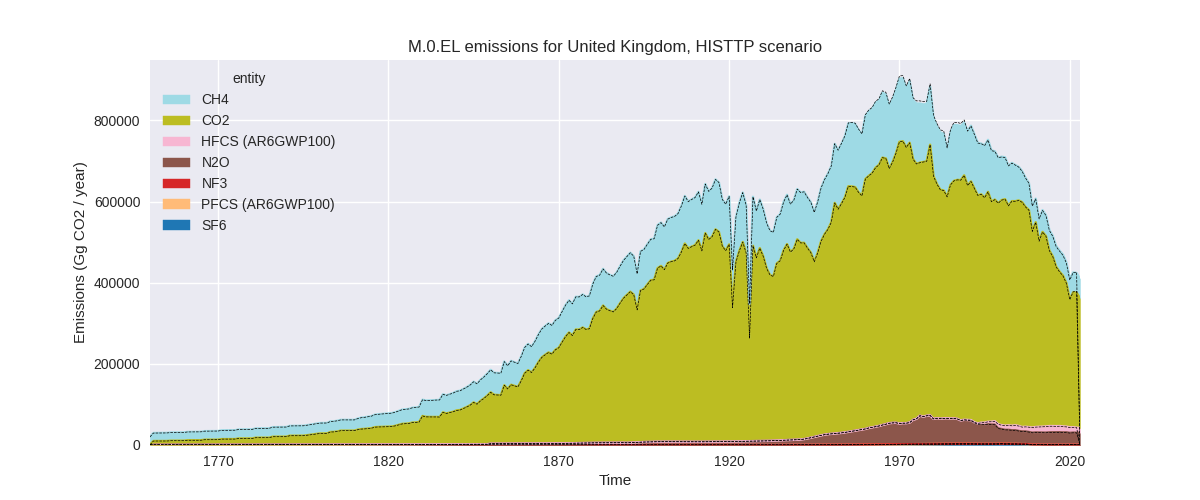
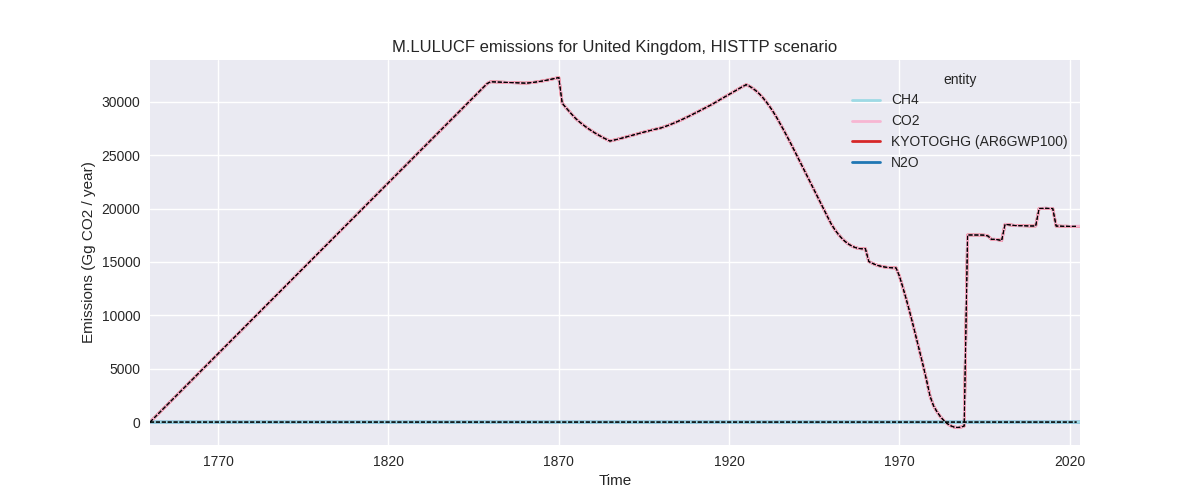
Overview over changes
In the country reported priority scenario we have the following changes for aggregate Kyoto GHG and national total emissions excluding LULUCF (M.0.EL):
- Emissions in 2022 have changed by -5.6%% (-23924.74 Gg CO2 / year)
- Emissions in 1990-2022 have changed by -1.0%% (-6412.25 Gg CO2 / year)
In the third party priority scenario we have the following changes for aggregate Kyoto GHG and national total emissions excluding LULUCF (M.0.EL):
- Emissions in 2022 have changed by -0.5%% (-2025.95 Gg CO2 / year)
- Emissions in 1990-2022 have changed by 0.1%% (546.29 Gg CO2 / year)
Most important changes per scenario and time frame
In the country reported priority scenario the following sector-gas combinations have the highest absolute impact on national total KyotoGHG (AR6GWP100) emissions in 2022 (top 5):
- 1: 1.A, CO2 with -18796.12 Gg CO2 / year (-5.8%)
- 2: 2, HFCS (AR6GWP100) with -4615.33 Gg CO2 / year (-35.7%)
- 3: M.AG.ELV, N2O with -1007.28 Gg CO2 / year (-8.5%)
- 4: 1.B.2, CH4 with -579.69 Gg CO2 / year (-12.2%)
- 5: 1.B.2, CO2 with 543.87 Gg CO2 / year (30.7%)
In the country reported priority scenario the following sector-gas combinations have the highest absolute impact on national total KyotoGHG (AR6GWP100) emissions in 1990-2022 (top 5):
- 1: 1.A, CO2 with -3943.80 Gg CO2 / year (-0.8%)
- 2: 2, HFCS (AR6GWP100) with -1543.29 Gg CO2 / year (-11.1%)
- 3: M.AG.ELV, N2O with -424.94 Gg CO2 / year (-3.3%)
- 4: 4, CH4 with -193.83 Gg CO2 / year (-0.4%)
- 5: M.AG.ELV, CH4 with -169.31 Gg CO2 / year (-59.5%)
In the third party priority scenario the following sector-gas combinations have the highest absolute impact on national total KyotoGHG (AR6GWP100) emissions in 2022 (top 5):
- 1: 1.A, CO2 with -3221.16 Gg CO2 / year (-1.0%)
- 2: 4, CH4 with 1360.17 Gg CO2 / year (13.7%)
- 3: 2, HFCS (AR6GWP100) with -764.64 Gg CO2 / year (-5.8%)
- 4: 4, N2O with 500.49 Gg CO2 / year (31.9%)
- 5: 1.B.1, CH4 with 232.43 Gg CO2 / year (50.6%)
In the third party priority scenario the following sector-gas combinations have the highest absolute impact on national total KyotoGHG (AR6GWP100) emissions in 1990-2022 (top 5):
- 1: 4, CH4 with 433.51 Gg CO2 / year (1.3%)
- 2: 4, N2O with 256.97 Gg CO2 / year (20.5%)
- 3: 1.A, CO2 with -152.74 Gg CO2 / year (-0.0%)
- 4: 2, HFCS (AR6GWP100) with -23.17 Gg CO2 / year (-0.2%)
- 5: 5, N2O with -20.88 Gg CO2 / year (-1.1%)
Notes on data changes
Here we list notes explaining important emissions changes for the country. ’' means that the following text only applies to the TP time series, while means that it only applies to the CR scenario. Otherwise the note applies to both scenarios.
- We have added the 2024 release of the official greenhouse gas inventory for the UK.
- The 2022 change in energy CO2 is due to a decrease in emissions in the official inventory while EI2023 shows increasing emissions for 2023.
- HFC emissions are lower in 2022 and in cumulative emissions because EEA2024 data is lower than CRF2023.
- In the CR scenario there are further smaller changes from the new country reported data.
- In the TP scenario the energy CO2 change for 2022 is from a slight reduction in emissions from EI2023 to EI2024.
- Changes in sectors 4 and 5 in the TP scenario are due to the removal of FAOSTAT data.
Changes by sector and gas
For each scenario and time frame the changes are displayed for all individual sectors and all individual gases. In the sector plot we use aggregate Kyoto GHGs in AR6GWP100. In the gas plot we usenational total emissions without LULUCF. ## country reported scenario
2022
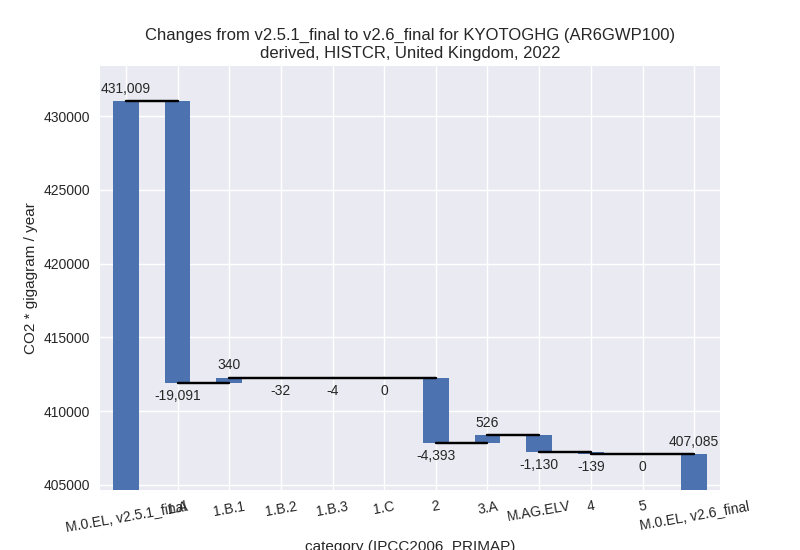
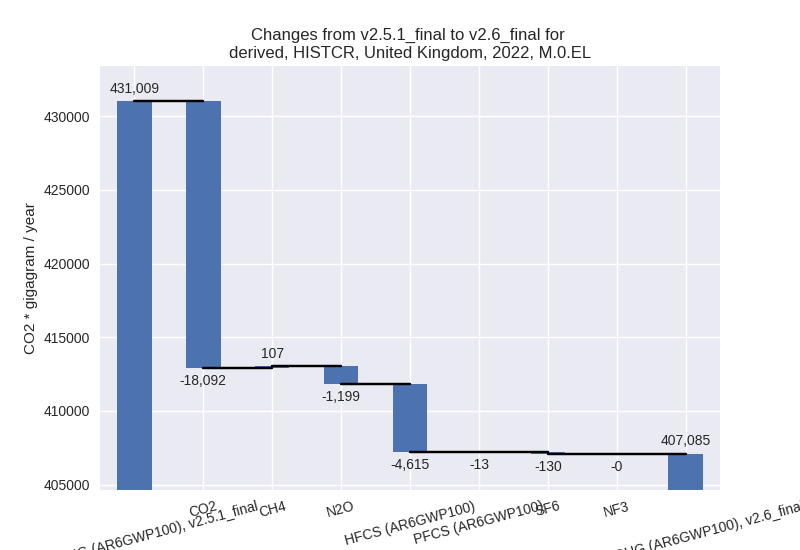
1990-2022
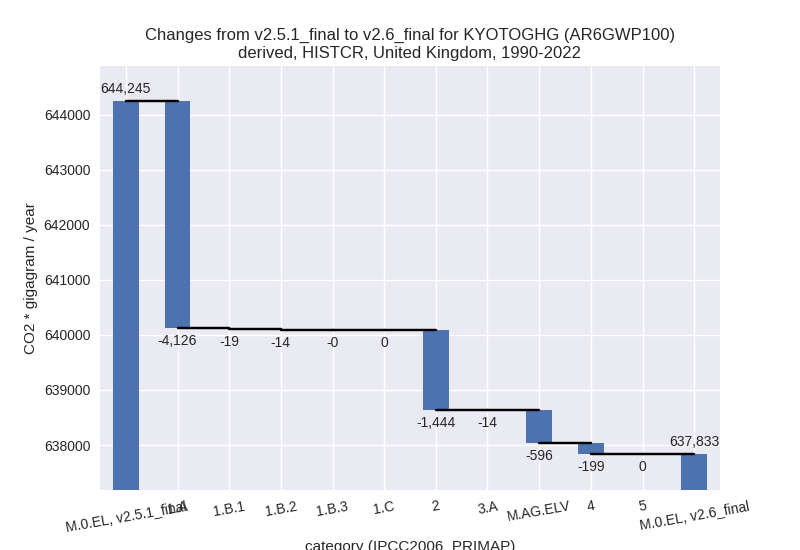

third party scenario
2022
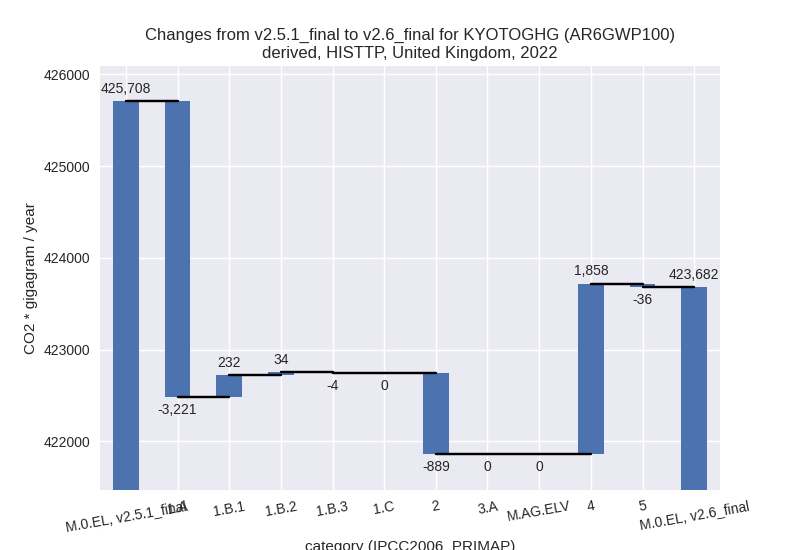
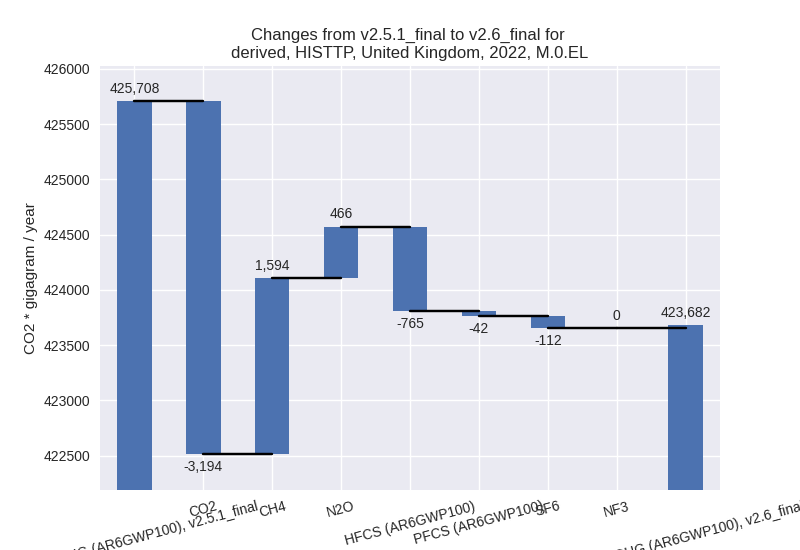
1990-2022
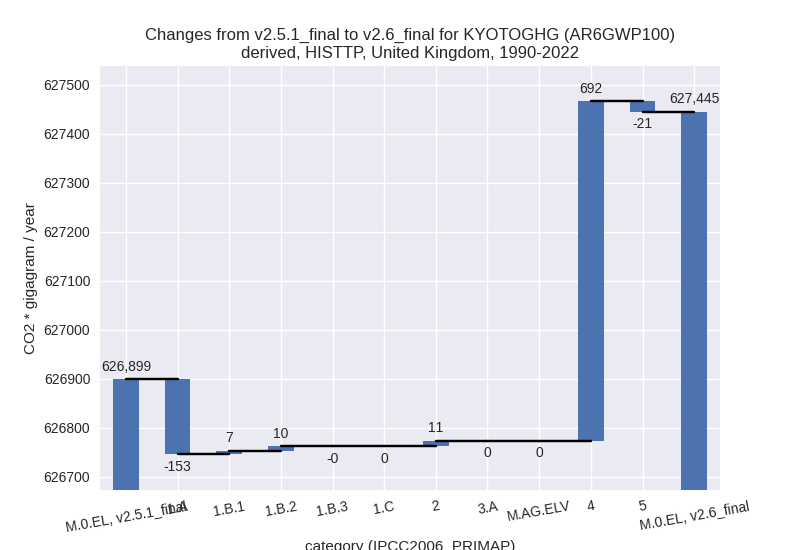
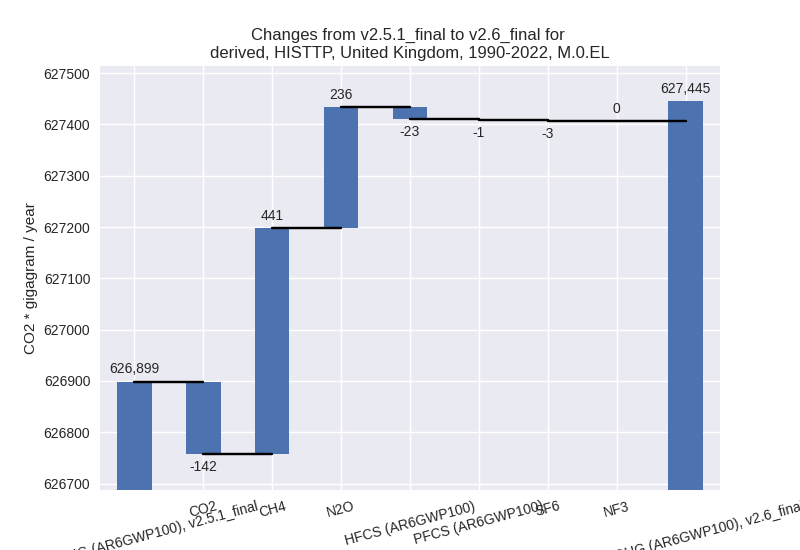
Detailed changes for the scenarios:
country reported scenario (HISTCR):
Most important changes per time frame
For 2022 the following sector-gas combinations have the highest absolute impact on national total KyotoGHG (AR6GWP100) emissions in 2022 (top 5):
- 1: 1.A, CO2 with -18796.12 Gg CO2 / year (-5.8%)
- 2: 2, HFCS (AR6GWP100) with -4615.33 Gg CO2 / year (-35.7%)
- 3: M.AG.ELV, N2O with -1007.28 Gg CO2 / year (-8.5%)
- 4: 1.B.2, CH4 with -579.69 Gg CO2 / year (-12.2%)
- 5: 1.B.2, CO2 with 543.87 Gg CO2 / year (30.7%)
For 1990-2022 the following sector-gas combinations have the highest absolute impact on national total KyotoGHG (AR6GWP100) emissions in 1990-2022 (top 5):
- 1: 1.A, CO2 with -3943.80 Gg CO2 / year (-0.8%)
- 2: 2, HFCS (AR6GWP100) with -1543.29 Gg CO2 / year (-11.1%)
- 3: M.AG.ELV, N2O with -424.94 Gg CO2 / year (-3.3%)
- 4: 4, CH4 with -193.83 Gg CO2 / year (-0.4%)
- 5: M.AG.ELV, CH4 with -169.31 Gg CO2 / year (-59.5%)
Changes in the main sectors for aggregate KyotoGHG (AR6GWP100) are
- 1: Total sectoral emissions in 2022 are 318126.40
Gg CO2 / year which is 78.1% of M.0.EL emissions. 2022 Emissions have
changed by -5.6% (-18788.04 Gg CO2 /
year). 1990-2022 Emissions have changed by -0.8% (-4159.19 Gg CO2 / year). For 2022
the changes per gas
are:
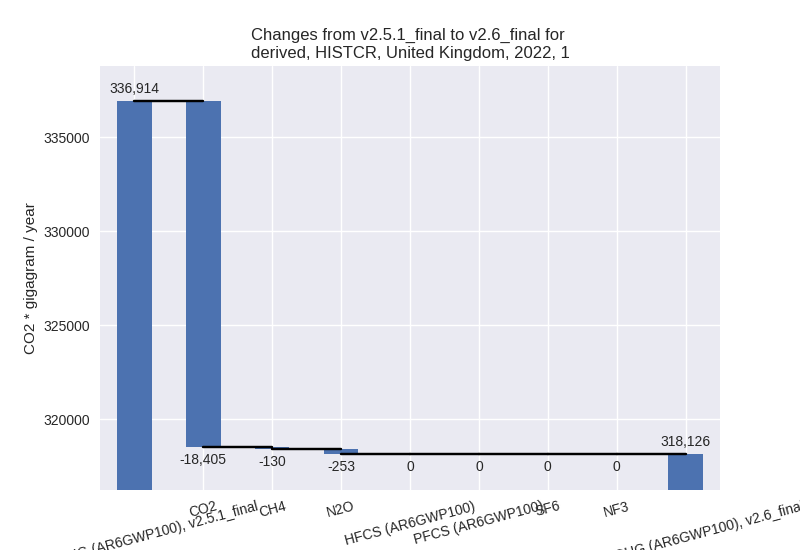
The changes come from the following subsectors:- 1.A: Total sectoral emissions in 2022 are 311116.45
Gg CO2 / year which is 97.8% of category 1 emissions. 2022 Emissions
have changed by -5.8% (-19090.86 Gg
CO2 / year). 1990-2022 Emissions have changed by -0.9% (-4125.84 Gg CO2 / year). For 2022
the changes per gas
are:
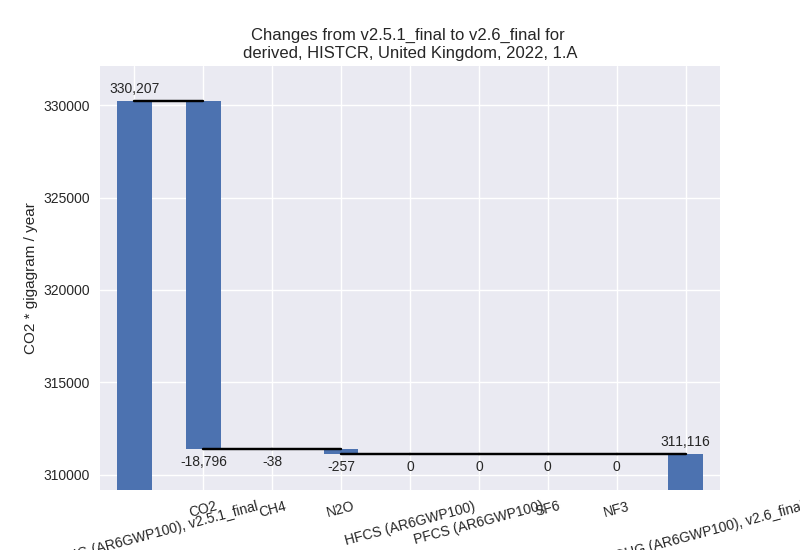
There is no subsector information available in PRIMAP-hist. - 1.B.1: Total sectoral emissions in 2022 are 492.71
Gg CO2 / year which is 0.2% of category 1 emissions. 2022 Emissions have
changed by 221.7% (339.56 Gg CO2 /
year). 1990-2022 Emissions have changed by -0.2% (-19.02 Gg CO2 / year). For 2022 the
changes per gas
are:
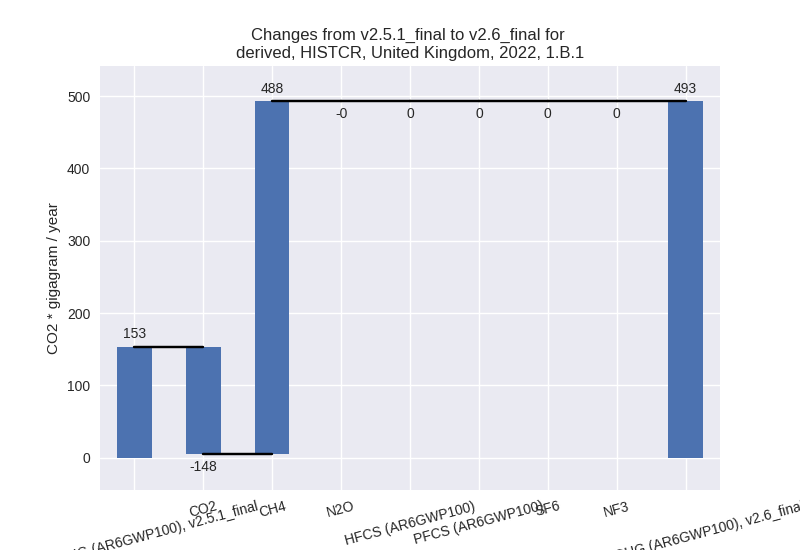
There is no subsector information available in PRIMAP-hist. - 1.B.2: Total sectoral emissions in 2022 are 6493.58 Gg CO2 / year which is 2.0% of category 1 emissions. 2022 Emissions have changed by -0.5% (-32.35 Gg CO2 / year). 1990-2022 Emissions have changed by -0.1% (-14.20 Gg CO2 / year).
- 1.A: Total sectoral emissions in 2022 are 311116.45
Gg CO2 / year which is 97.8% of category 1 emissions. 2022 Emissions
have changed by -5.8% (-19090.86 Gg
CO2 / year). 1990-2022 Emissions have changed by -0.9% (-4125.84 Gg CO2 / year). For 2022
the changes per gas
are:
- 2: Total sectoral emissions in 2022 are 28101.65 Gg
CO2 / year which is 6.9% of M.0.EL emissions. 2022 Emissions have
changed by -13.5% (-4393.45 Gg CO2 /
year). 1990-2022 Emissions have changed by -2.6% (-1443.88 Gg CO2 / year). For 2022
the changes per gas
are:
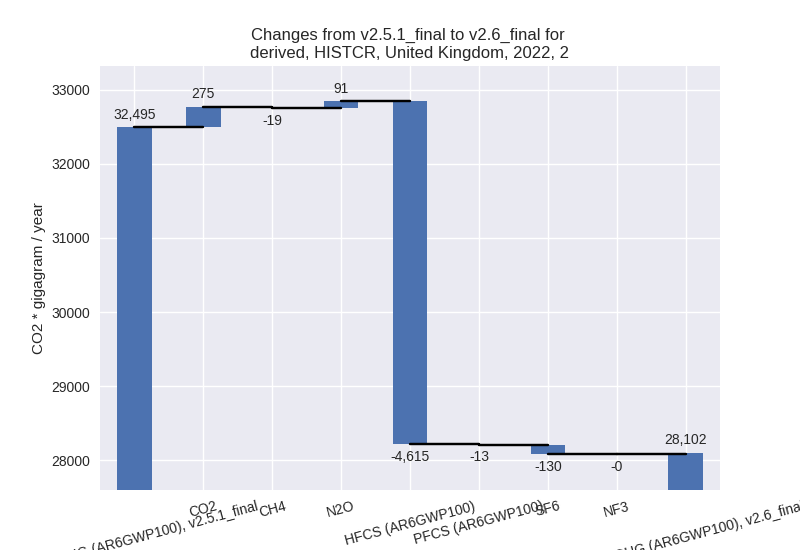
For 1990-2022 the changes per gas are: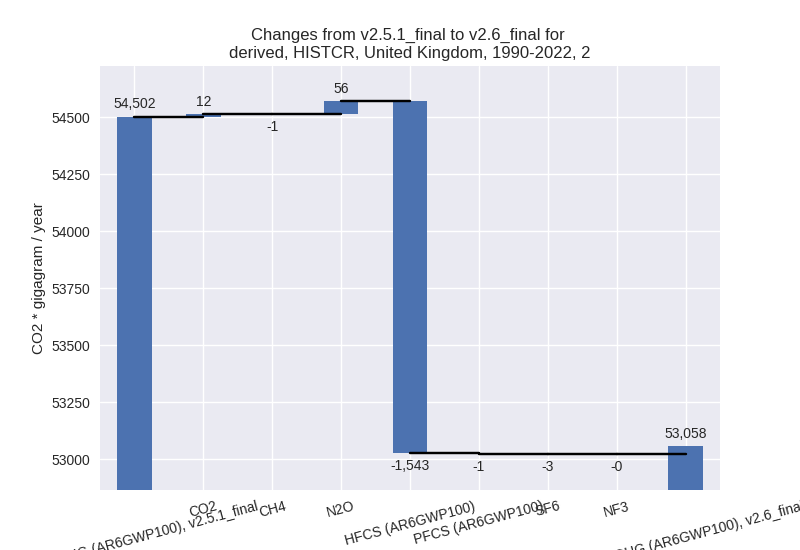
- M.AG: Total sectoral emissions in 2022 are 42104.46 Gg CO2 / year which is 10.3% of M.0.EL emissions. 2022 Emissions have changed by -1.4% (-604.28 Gg CO2 / year). 1990-2022 Emissions have changed by -1.3% (-609.94 Gg CO2 / year).
- 4: Total sectoral emissions in 2022 are 18752.20 Gg CO2 / year which is 4.6% of M.0.EL emissions. 2022 Emissions have changed by -0.7% (-138.97 Gg CO2 / year). 1990-2022 Emissions have changed by -0.4% (-199.23 Gg CO2 / year).
- 5: No data
third party scenario (HISTTP):
Most important changes per time frame
For 2022 the following sector-gas combinations have the highest absolute impact on national total KyotoGHG (AR6GWP100) emissions in 2022 (top 5):
- 1: 1.A, CO2 with -3221.16 Gg CO2 / year (-1.0%)
- 2: 4, CH4 with 1360.17 Gg CO2 / year (13.7%)
- 3: 2, HFCS (AR6GWP100) with -764.64 Gg CO2 / year (-5.8%)
- 4: 4, N2O with 500.49 Gg CO2 / year (31.9%)
- 5: 1.B.1, CH4 with 232.43 Gg CO2 / year (50.6%)
For 1990-2022 the following sector-gas combinations have the highest absolute impact on national total KyotoGHG (AR6GWP100) emissions in 1990-2022 (top 5):
- 1: 4, CH4 with 433.51 Gg CO2 / year (1.3%)
- 2: 4, N2O with 256.97 Gg CO2 / year (20.5%)
- 3: 1.A, CO2 with -152.74 Gg CO2 / year (-0.0%)
- 4: 2, HFCS (AR6GWP100) with -23.17 Gg CO2 / year (-0.2%)
- 5: 5, N2O with -20.88 Gg CO2 / year (-1.1%)
Changes in the main sectors for aggregate KyotoGHG (AR6GWP100) are
- 1: Total sectoral emissions in 2022 are 329113.59 Gg CO2 / year which is 77.7% of M.0.EL emissions. 2022 Emissions have changed by -0.9% (-2958.96 Gg CO2 / year). 1990-2022 Emissions have changed by -0.0% (-136.13 Gg CO2 / year).
- 2: Total sectoral emissions in 2022 are 26232.04 Gg
CO2 / year which is 6.2% of M.0.EL emissions. 2022 Emissions have
changed by -3.3% (-888.95 Gg CO2 /
year). 1990-2022 Emissions have changed by 0.0% (11.28 Gg CO2 / year). For 2022 the
changes per gas
are:
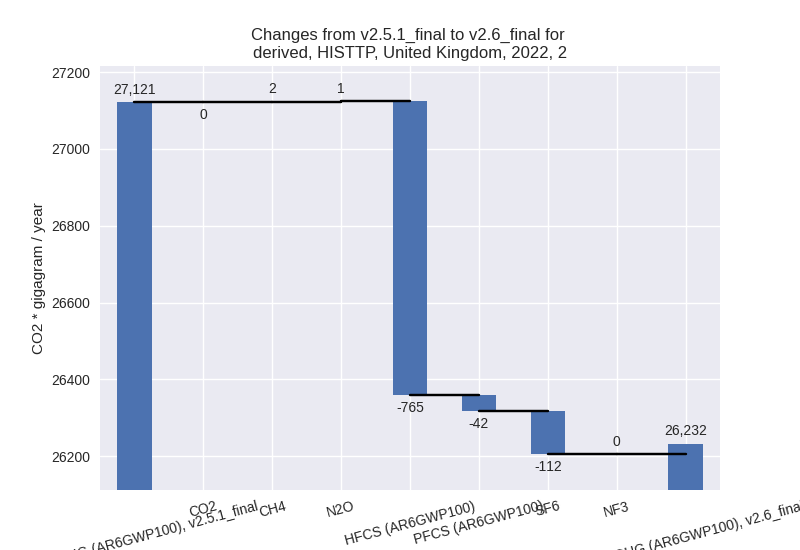
- M.AG: Total sectoral emissions in 2022 are 53998.83 Gg CO2 / year which is 12.7% of M.0.EL emissions. 2022 Emissions have changed by 0.0% (0.00 Gg CO2 / year). 1990-2022 Emissions have changed by 0.0% (0.00 Gg CO2 / year).
- 4: Total sectoral emissions in 2022 are 13442.03 Gg
CO2 / year which is 3.2% of M.0.EL emissions. 2022 Emissions have
changed by 16.0% (1857.97 Gg CO2 /
year). 1990-2022 Emissions have changed by 2.0% (692.02 Gg CO2 / year). For 2022 the
changes per gas
are:
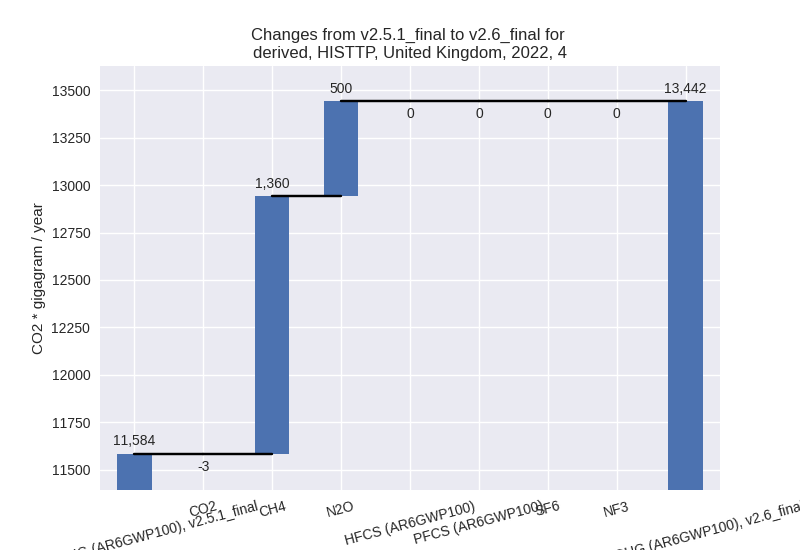
- 5: Total sectoral emissions in 2022 are 895.12 Gg
CO2 / year which is 0.2% of M.0.EL emissions. 2022 Emissions have
changed by -3.9% (-36.01 Gg CO2 /
year). 1990-2022 Emissions have changed by -1.1% (-20.88 Gg CO2 / year). For 2022 the
changes per gas
are:
